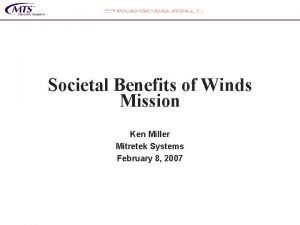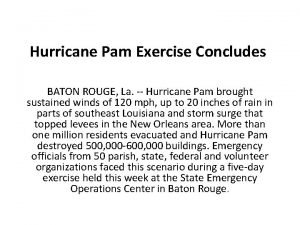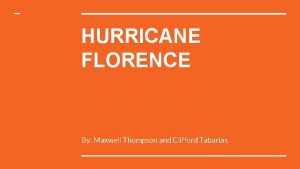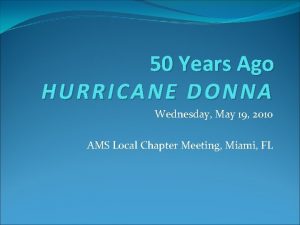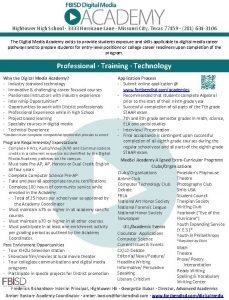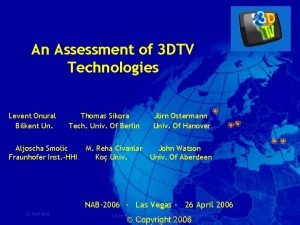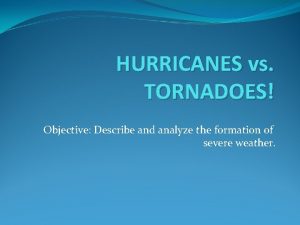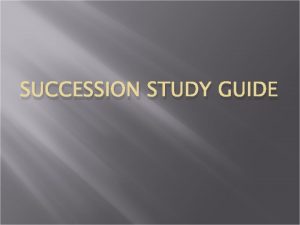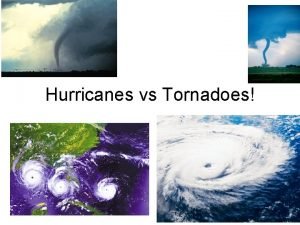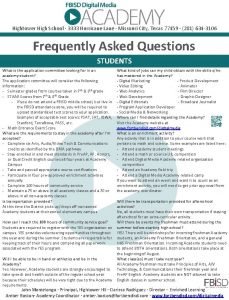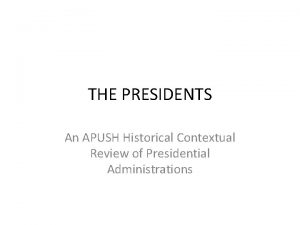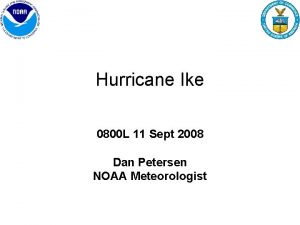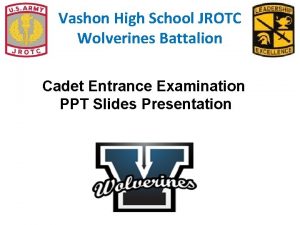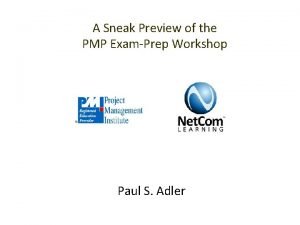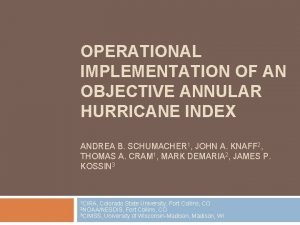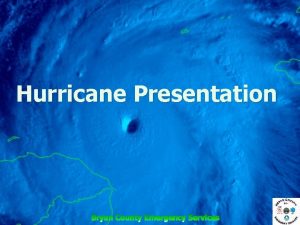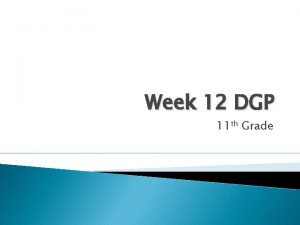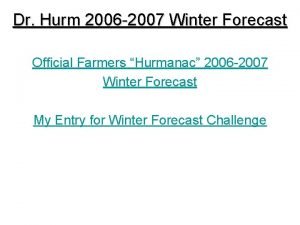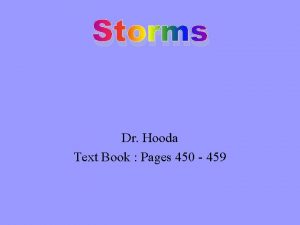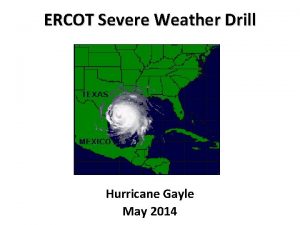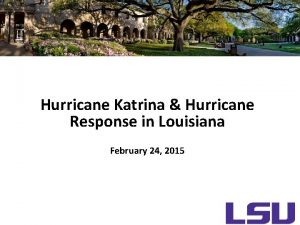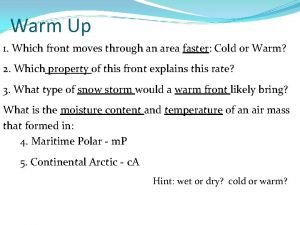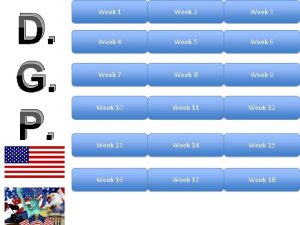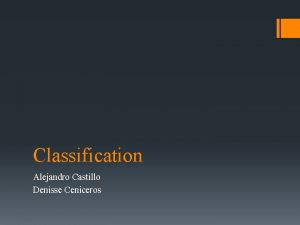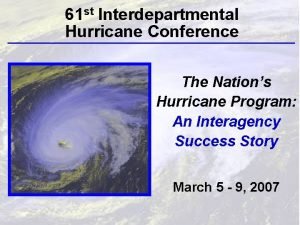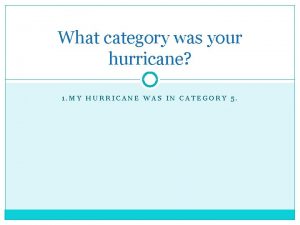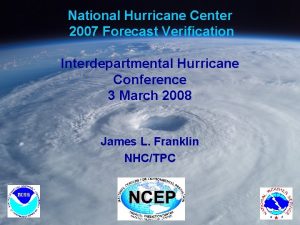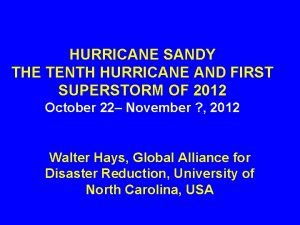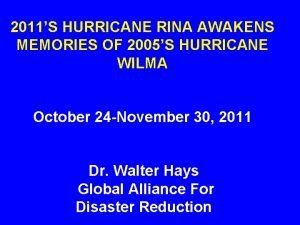st 1 Q wk 5 6 Hurricane all


















































- Slides: 50

st 1 Q, wk #5 -6 Hurricane all of week #5 (Sept 11 -15) Week # 6, (Sept. 18 -22)

Bellringer, 9/18 (Reg. and Hon. ) (Review of The Crucible characters) You will need to use notebook paper for your bellringers this week. Please write the date before answering the bellringer. Choose from the following list of characters to identify each one. List: Abigail, Rev. Parris, Betty, Mrs. Putnam, Mercy Lewis, Susanna Walcott, Ruth Putnam 1. Minister in Salem 2. Lost 7 kids immediately after childbirth 3. A young girl that brought news from the doctor 4. Leader of the girls in the woods; Rev. Parris’s niece 5. Young girl lying sick, unmoving 6. Young girl lying sick, eyes open but unresponsive 7. One of the girls in the woods that ran naked

Activity, Hon 9/18 • Continue reading Act I and completing chart of comparison/contrast (or Venn Diagram) of the play details to the historical account of the Salem witch trials • New assignment date for essay: Tuesday, Sept. 26 th

Activity, Reg. 9/18 • Your vocab word list is being returned (without a stamp) so you can add words from today’s reading that may be unfamiliar to you, as well as your guess on what the word might mean • Continue reading Act I and add to chart • Turn in chart at end of class period for another stamp

Bellringer, Hon. 9/19 • 1) Choose one detail from your chart that shows a difference between the play and the historical event and write it down. • 2) Next, make a guess why the author made this change

Activity, Hon. , 9/19 • Continue adding details to your chart as we continue reading Act I • You will turn in chart for a stamp grade tomorrow • (To receive a stamp, you should have at least two kinds of differences and two similarities. )

Bellringer, Reg. , 9/19 (group work) • Make word wall cards for the Act I vocab words: • Put your desks together as a group. Use the number on your desk to determine what you will do with the two word cards you are given. #1: Write the definition for each word #2: Write a synonym for each word #3: Write an antonym (or what the word is NOT) for each word #4: Draw an illustration to match each word

Words assigned to each group • Blue: pulpit, inert • Green: faction, dissembling • Red: abomination, subservient • Yellow: naught, spareness • Pink: clamored, prodigious • Orange: trafficked (with), unmellowed • Brown: begrudge, ail

9/19, 4 th per – Group questions for Act I Answer these questions about pp. 458 -468 on your team’s white board • Question #1: • Write all of the following that are true about the character of Abigail: • • • A. She has a capacity for dissembling B. She is the 11 yr. old daughter of Rev. Parris C. She is Betty’s cousin D. She lives with Rev. Parris and Betty E. She is the leader of the girls in the woods

Question #2 True or False: Tituba is a slave from Barbados who belongs to Rev. Parris.

Question #3: • What is wrong with Betty? • A. She walks around in a daze • B. She remains inert on the bed since Rev. Parris came on them in the woods • C. She speaks gibberish • D. Nothing

Question #4: • Why does Parris suggest calling in Reverend Hale? • A. He is a specialist in detecting witches/witchcraft • B. He is a doctor that specializes in rare diseases • C. Rev. Parris is too upset to preach and needs Rev. Hale to fill the pulpit • D. Rev. Parris needs some spiritual counseling

Question #5: What is the motivation for Ann and Thomas Putnam suggesting that Betty’s problem is witchcraft? A. They never liked Betty and want to produce scandal about her B. They like to stir up trouble in the town C. They are looking for a witch to blame for the deaths of their children D. They are trying to cause trouble for Rev. Parris so he will be fired

Question #6: • What does the conversation between Abigail, Mercy Lewis, Mary Warren, and Betty reveal about their recent activities? A. They haven’t told the whole truth about what happened in the woods B. Betty is evidently faking her illness C. Abigail is feared by the girls D. Two of their activities included conjuring spirits of dead babies to speak to them and drinking blood to put a curse on someone • E. All of the above • F. None of the above • •

Winners receive a prize!!! • Now open up books to continue reading Act I

Bellringer, Hon. 9/20 • 1) In your own words, describe John Proctor. Give two pieces of textual evidence that supports your description. (The play begins on p. 458)

Activity, 9/20 Hon. • Continue reading and charting • Turn in charts for a stamp grade

Activity: Group formative on characters • Each group is assigned a character to study: • Red group: John Proctor • Yellow group: Paris • Brown group: Abigail • Orange group: Hale • Blue group: Mr. Putnam • Green group: Mrs. Putnam • Pink group: Giles Cory

Make one chart for the group: • #1, #2, #3: Each of you write a character trait of your assigned character and quote evidence that proves it. (Place the line numbers next to the quoted evidence. ) • #4: Identify a conflict your character has with another character and quote evidence that proves it. (Place the line numbers next to the quoted evidence. ) • Example: • GROUP COLOR: _______ • CHARACTER NAME: Abigail • CHARACTER EVIDENCE LINE #’S TRAIT • _______________________________________ • dissembles "Abigail Williams, 35 -38 • (hides truth) a girl of seventeen, … • with an endless capacity • for dissembling. "

Bellringer, Reg. 9/20 • Write a word to describe Abigail. Then quote a piece of evidence from the play that supports your description. (The play begins on p. 458 in the book).

Activity, 9/20 Reg. • As we read, answer these questions on your paper. You will turn these in at end of period: (Quiz Q’s 1 -4)

Bellringer, 9/21 Hon. • In your words, what is the difference between sufficient evidence and elaboration and thorough evidence and elaboration?

Activity: Writing Workshop • Each group is provided with the following supplies: • A computer • An article about two baseball parks—the new Yankee stadium and Citifield, the new stadium for the Mets (both in New York)—with labeled text for each group member • Those supporting Yankee stadium are Blue, Orange, Red, and Brown • Those supporting Citifield are Green, Yellow, and Pink

Directions—first 10 minutes • First, person #3 in the group should set up a Word document on your One. Drive with the name of your group color and period number as the title • Each group member is assigned to read the portion of a text marked for him/her and record evidence found in it on that word document • You are to record evidence from your portion that could be used to prove that stadium is better/more preferred than the other one • Then share that document on One. Drive with Mrs. Hicks (type in pjhicks and my name should come up; then send)

Review • Now look at the rubric for scoring Evidence and Elaboration. How do you write that paragraph to receive a score of 4 (thorough) rather than 3 (sufficient)? • Let’s look at the slides on expressing evidence and elaboration

Bellringer, 9/22 Hon. • In review of yesterday’s lesson, what would you add or change to yesterday’s answer of what makes a paragraph thorough (score a 4) in evidence and elaboration? • Turn in bellringer papers to tray when you are finished.

Step #2 • View the combined evidence for both sides

Step #3 • As a group, discuss possible reasons you could choose for supporting the claim that your stadium is better • Choose one reason (make sure you have at least 2 pieces of evidence to support that reason) • On your original group document, type the topic sentence of your paragraph (i. e. , One reason ___ stadium is a superior stadium is …)

Evidence • Evidence is any statement, whether it is in your words or directly quoted, that is written in the texts provided to you • If you use any of these words or ideas in your essay, you must say which source had those words or ideas. • You can identify the source by just giving the author’s last name of the source. You can write it in the sentence or put it in parenthesis after the sentence. • Ex: According to Miriam Dodge, students that participate in community service during school usually graduate at a higher rate than students who do not. • Ex: Others agree that “multitask is a skill that they will need in both work and college environments” (Dodge). • Ex: One reason that community service should be required is that it helps students to manage their time and responsibilities (Dodge).

Evidence, cont. • Evidence can be summarized, paraphrased, or quoted. • Ex. Summary: There are those who disagree with requiring community service because it devalues the act of volunteering (Dodge). • Ex. Paraphrase: There are students and parents who do not support requiring community service to graduate. They say that volunteering in and of itself should be selfless and given, which the requirement takes away. They also feel strongly that it takes away the reward of giving to the point that the student may stop any future volunteer acts (Dodge). • Ex. Quote: “Not all students—or parents—support this mandate as an additional criterion to required coursework. For one thing, making a selfless act a requirement for graduating negates the spirit of volunteerism itself…does not teach him or her the true value of donating time. The student will not feel the reward…may not be inclined to volunteer in the future” (Dodge)

Elaboration • Evidence needs to be sandwiched in between an introduction of the evidence and an explanation of how that evidence supports the claim Think of it like a sandwich: Top bun: introduction Meat: evidence Bottom bun: explanation This Photo by Unknown Author is licensed under CC BY-SA Make sure each body paragraph has at least one sandwich in it. Of course, a double-decker (more than one piece of evidence) is even better!

Example of sandwiched evidence: (sufficient) • The new Yankee Stadium is superior to Citifield because it has kept the nostalgia of the old stadium while still making improvements. The architects realized that baseball fans go to games as much to relive the glory days as to enjoy new experiences. Therefore, the new stadium “has tried hard, very hard, to make us think of its predecessor” while also adding “clearer sight lines, luxury suites” and other amenities (Goldberg), a wise move of the architect. Incorporating the old with the new reassures fans that their good memories at the ballpark will not be destroyed.

More than one sandwich = more thorough support and more effective use of sources, details, facts The new Yankee Stadium is superior to Citifield because it has kept the nostalgia of the old stadium while still making improvements. The architects realized that baseball fans go to games as much to relive the glory days as to enjoy new experiences. Therefore, the new stadium “has tried hard, very hard, to make us think of its predecessor” while also adding “clearer sight lines, luxury suites” and other amenities (Goldberg), a wise move of the architect. Incorporating the old with the new reassures fans that their good memories at the ballpark will not be destroyed. In fact, Nicolai Ouroussoff, in his “Architecture Review” goes so far as to describe the stadium as a “stoic, self-conscious monument to history. ” He reminds the readers that the old park witnessed 26 World Series championships, which posed a challenge for management when they wanted to replace it. By adding the architectural feature of a reproduction of a scalloped frieze that had been a part of the old stadium, the designers succeeded in creating an effect of “soaking up the stadium’s noble lineage”, as Goldberger put it, which results in a fan feeling honored to be part of one more historic experience.

Your turn… • As a group, write your paragraph, trying to incorporate as many pieces of evidence as you can to prove your point, smoothly integrating them into the sandwich of your elaboration. ( I will give you a copy of the other text, so you have both to look at. ) • Try to use evidence from both resources in your paragraph. • Try to express it in more than one way (quoting, summarizing, paraphrasing) • Be sure to give credit to the source for all information you include from them. • Blue, Orange, Green: Ouroussoff • Brown, Red, Yellow, and Pink: Goldberger

Directions. . • Have the same person (#3) in your group bring up the document of evidence you shared with me yesterday. • Add the paragraph to the end of that document. • I will grade it and the entire group will receive the same grade. (Graded based on evidence/elaboration section of rubric) • 4— 100 • 3— 80 • 2— 70 • 1 --60

Bellringer, Reg. 9/21 • Answer the following statements true or false: • 1. Abigail and John Proctor had an affair, and Rev. Parris knows about it. • 2. Betty and Ruth are the two girls who are afflicted with a strange sickness. • 3. John Proctor does not like the way Rev. Parris preaches. • 4. Mr. Putnam thinks he can push people around because he is a big land owner in town. • 5. Mr. and Mrs. Putnam hope that no witchcraft will be found in Salem.

Activity, 9/20 Reg. • We will finish reading Act I. As we do, you will answer the following questions on paper, which will be turned in for a grade at the end of class today. • (Quiz Q’s #1 -5)

Bellringer, Reg. 9/22 • What makes an argumentative essay sufficient in organization, focus, purpose, and style? What makes it sufficient in evidence and elaboration?

Writing workshop--Organization • To be sufficient, an argumentative essay needs to have these necessary parts: • Introduction with a clear claim • At least 2 body paragraphs, each one giving one good reason to support that claim • Mention of the counterclaim and at least one reason why that claim is supported by others (this can be a separate paragraph) • A conclusion that mentions the claim and its arguments of support again, with one final comment on the subject

Focus • The claim has to be about what the prompt asks and only that aspect of the topic should be covered in the writing • Ex. : your VLT— • The topic is whether or not community service should be REQUIRED for graduation • Off-topic: community service should be done • Off-topic: community service is good or bad • Off-topic: a summary of what the two articles say

Style- • The paper’s style must be objective, not personal, not informal, not merely persuasive • THEREFORE, do NOT use these words in your essay: • I, me, my, we, us, our • You, your • Slang words or expressions, insulting words (i. e. , stupid, sucks, lame)

Evidence • Evidence is any statement, whether it is in your words or directly quoted, that is written in the texts provided to you • If you use any of these words or ideas in your essay, you must say which source had those words or ideas. • You can identify the source by just giving the author’s last name of the source. You can write it in the sentence or put it in parenthesis after the sentence. • Ex: According to Miriam Dodge, students that participate in community service during school usually graduate at a higher rate than students who do not. • Ex: Others agree that “multitask is a skill that they will need in both work and college environments” (Dodge). • Ex: One reason that community service should be required is that it helps students to manage their time and responsibilities (Dodge).

Evidence, cont. • Evidence can be summarized, paraphrased, or quoted. • Ex. Summary: There are those who disagree with requiring community service because it devalues the act of volunteering (Dodge). • Ex. Paraphrase: There are students and parents who do not support requiring community service to graduate. They say that volunteering in and of itself should be selfless and given, which the requirement takes away. They also feel strongly that it takes away the reward of giving to the point that the student may stop any future volunteer acts (Dodge). • Ex. Quote: “Not all students—or parents—support this mandate as an additional criterion to required coursework. For one thing, making a selfless act a requirement for graduating negates the spirit of volunteerism itself…does not teach him or her the true value of donating time. The student will not feel the reward…may not be inclined to volunteer in the future” (Dodge)

Elaboration • Evidence needs to be sandwiched in between an introduction of the evidence and an explanation of how that evidence supports the claim Think of it like a sandwich: Top bun: introduction Meat: evidence Bottom bun: explanation This Photo by Unknown Author is licensed under CC BY-SA Make sure each body paragraph has at least one sandwich in it. Of course, a double-decker (more than one piece of evidence) is even better!

Example of “sandwiched” evidence: • Claim: Community service should be an added requirement to graduation from high school. • One reason the requirement to do community service should be in place is because of the skills gained which benefit the student. Students become better at managing their lives in and out of school when they have the experience of community service. As Miriam Dodge points out in her editorial, volunteer work helps students “to schedule their time and learn how to juggle responsibilities” as well as “learn the value of responsibility and discipline”. These skills are not only necessary after graduation, they are vital to greater success. A student who has not learned these skills will be at a disadvantage in college and career. See the sandwich?

More than one sandwich… • You can always have more than one sandwich in each paragraph. Here’s an example of that same paragraph with an additional sandwich of evidence and elaboration: • One reason the requirement to do community service should be in place is because of the skills gained which benefit the student. Students become better at managing their lives in and out of school when they have the experience of community service. As Miriam Dodge points out in her editorial, volunteer work helps students “to schedule their time and learn how to juggle responsibilities” as well as “learn the value of responsibility and discipline”. These skills are not only necessary after graduation, they are vital to greater success. A student who has not learned these skills will be at a disadvantage in college and career. Other skills that benefit the student who participates in community service are what Robert Hopkins calls “transferable skills” (Gupta). These are skills that can be applied to situations in the school or community that broadens the student’s ability to understand school concepts and act in society needs, like homelessness or natural disaster clean up. Every graduate should go out into the world with such training benefits.

You will now rotate to different writing centers to get a practice in each of these areas of writing an essay • Station #1: Focus/introduction • Station #2: Style (objective and academic) • Station #3: Evidence: making an evidence sandwich • Station #4: Evidence: organizing into reasons • Station #5: Putting it all together: Paragraph writing (must complete #1 -4 before you can do this station)

Station #5 • Take one of the reasons you listed in Station #4 and use the text evidence provided to write the paragraph on your answer sheet, starting with the topic sentence (the reason) and sandwiching including at least two pieces of evidence in the paragraph that help support it. Be sure to explain how the evidence proves that point. When you use the evidence, tell what text it came from (Text #1, Text #2, etc. )

4 th period: Monday and Tuesday of next week: • You will receive back your VLT-Argumentative Essay with your scores and my feedback on them. • You have Monday and Tuesday’s class time to rewrite your essay for a better grade. • YOU MUST STAPLE YOUR REWRITE TO YOUR ORIGINAL, OR I WILL NOT ACCEPT IT!!! So keep your original in your folder until you turn it back in. • If you choose not to rewrite anything, just turn the original essay back into the tray and that will be your summative score on the VLT as well.

Honors: Monday and Tuesday of next week • You will have these two days in class to write your essay comparing/contrasting the historical Salem Witch Trials to the details in Act I of The Crucible.
 Name all rays
Name all rays Hurricane measurement
Hurricane measurement Ihc hurricane
Ihc hurricane Hurricane insert name
Hurricane insert name What was hurricane pam
What was hurricane pam Hmon
Hmon Hurricane florence statistics
Hurricane florence statistics Hurricane season turks and caicos
Hurricane season turks and caicos Hilton head gis
Hilton head gis What year was hurricane donna
What year was hurricane donna Hurricane math
Hurricane math 3333 hurricane lane missouri city
3333 hurricane lane missouri city 2006 hurricane season
2006 hurricane season Hurricane myths and legends
Hurricane myths and legends Hurricane and tornado venn diagram
Hurricane and tornado venn diagram Hurricane tropical storm forecast
Hurricane tropical storm forecast Carnot cycle hurricane
Carnot cycle hurricane Hurricane fall lost in us lyrics
Hurricane fall lost in us lyrics What type of succession occurs after a hurricane
What type of succession occurs after a hurricane Similarities between tornadoes and hurricanes
Similarities between tornadoes and hurricanes Gfs typhoon
Gfs typhoon 3333 hurricane lane missouri city
3333 hurricane lane missouri city Hurricane katrina apush
Hurricane katrina apush Florida hurricane catastrophe fund
Florida hurricane catastrophe fund September 2008 hurricane
September 2008 hurricane Mhs hurricane battalion
Mhs hurricane battalion Hurricane signs
Hurricane signs Cross section of a hurricane
Cross section of a hurricane Hurricane karl 2010
Hurricane karl 2010 What is an annular hurricane
What is an annular hurricane 1898 georgia hurricane
1898 georgia hurricane Dgp week 12
Dgp week 12 Raleighwx
Raleighwx Hurricane hooda
Hurricane hooda Barbados hurricane risk
Barbados hurricane risk Hurricane gayle
Hurricane gayle Hurricane matthew case study
Hurricane matthew case study Compare and contrast hurricanes and tornadoes
Compare and contrast hurricanes and tornadoes Hurricane tropical storm forecast
Hurricane tropical storm forecast Hurricane outflow
Hurricane outflow Hurricane hazel track
Hurricane hazel track Hurricane rules
Hurricane rules Which of the following is true concerning hurricanes?
Which of the following is true concerning hurricanes? Tornado categories
Tornado categories Contraflow new orleans
Contraflow new orleans Raging planet hurricane worksheet answer key
Raging planet hurricane worksheet answer key Cannibal canoe hurricane and barbecue
Cannibal canoe hurricane and barbecue Severe weather graphic organizer
Severe weather graphic organizer Hurricane pam
Hurricane pam Historical hurricane tracks
Historical hurricane tracks Hurricane webquest
Hurricane webquest

